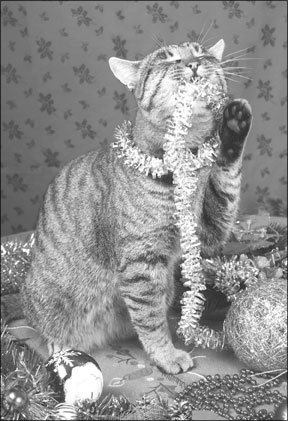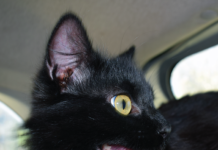Osteoarthritis in Cats There is a growing understanding of osteoarthritis (OA) – also called degenerative joint disease – in cats that has led to investigation of the clinical signs, radiographic findings and also treatments. Cats are very good at compensating for orthopedic 288 diseases, and therefore the clinical signs of arthritis are more difficult to detect and are different than those seen in dogs. Unfortunately, osteoarthritis has an fundamental impact on mobility, activity and quality of life. This study (Cross-sectional study of the prevalence and clinical features of osteoarthritis in 100 cats, Veterinary Journal, 2010) evaluated 100 cats over the age of six years. Each cat had a physical examination and had radiographs taken of the front and hind limbs, and owners were asked to fill out a questionnaire about their cats behavior. Osteoarthritis was most common in the shoulders, elbows, hips and tarsal joints. The majority of cats (61 percent) had OA in at least one joint, and 48 percent had OA in more than one joint. Factors related to the presence of OA included advancing age, decreased mobility and grooming, and increased inappropriate elimination. This study supports findings of other studies in the last 10 years, and it reinforces the fact that OA is very common in middle-aged and older cats, and is associated with behavior changes. A Study on Vestibular Disease In this study (Clinical signs, magnetic resonance imaging findings and outcome in 77 cats with vestibular disease: a retrospective study, Journal of Feline Medicine & Surgery, 2010), the medical records of 77 cats were reviewed to include the epidemiology, clinical and MRI findings in cats with vestibular signs – and to identify any association between these variables and patient outcome. Vestibular disease includes a loss of balance, typical ataxia, head tilt, spontaneous/positional nystagmus and/or positional strabismus. Cats with these signs alone were classified with peripheral vestibular disease (PVD). Cats with a markedly depressed mental state, proprioceptive deficits and cranial nerve deficits were classified with central vestibular disease (CVD). Forty cats (52 percent) were designated to have unilateral CVD, one cat had paradoxical vestibular syndrome, and the remaining 36 (47 percent) cats had PVD, of which five had bilateral clinical signs. The most frequent cause of CVD was inflammation including bacterial inflammation as an extension of intracranial otitis interna, feline infectious peritonitis and toxoplasmosis. Neoplasia was in second place and vascular disease in third as causes of CVD. In cats with PVD signs, idiopathic conditions and otitis media/interna were equally represented. Most of the cats (9 cases) with presumed idiopathic vestibular disease had rapid and complete recovery. Statistically significant predictors of survival included neurolocalization (central or peripheral vestibular system), age and gender. Magnetic resonance imaging (MRI) was found to be very useful in the diagnosis of both peripheral and central vestibular disease. Prognosis appears to be directly associated with the site (intracranial versus extracranial) rather than the nature of the lesion. Holiday Hazards Reminder Most cat owners are aware of the various dangers that the holiday season can bring into our homes, like sparkly tinsel and pretty ribbon that can delight us – but provide potential danger to our beloved pets. Its important to remember that poinsettias can indeed irritate the mouth and stomach of your cat, but that lilies are even more toxic. Ingestion of even a tiny amount can result in kidney failure in your cat, so be extra careful of the plants that you or your guests bring into your home. We may find chocolate to be delicious, but its never good for a cat to eat. However, you may not realize that dark chocolate is far more dangerous because of its high levels of methylxanthines. And for some cats, the stress and activities of the holidays can become overwhelming. You can try synthetic pheromones, such as Feliway, but the best solution may be to create a quiet, safe “cats only” room for your pet to seek comfort and peace.



